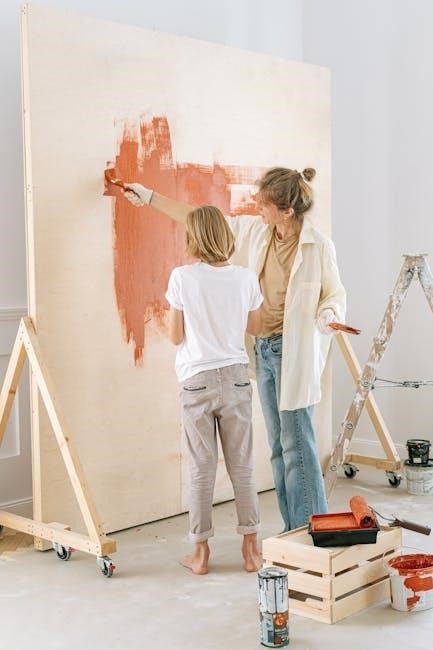Wall Art Size Guide: Free Guide
Unlock the secrets to perfectly sized wall art with our free guide! Discover how to transform your walls into stunning focal points‚ creating harmonious spaces․ We offer expert advice‚ visual examples‚ and essential tips to help you select the ideal art dimensions․

Selecting the right size of wall art can dramatically impact the aesthetic appeal and overall feel of any room․ It’s more than just picking a piece you like; it involves understanding proportions‚ considering the space available‚ and harmonizing the artwork with existing furniture and décor․ This guide serves as your comprehensive resource for navigating the world of wall art sizing‚ ensuring you make informed decisions that elevate your living spaces․
We’ll delve into the importance of scale‚ demonstrating how a properly sized piece can create balance and visual interest‚ while an incorrectly sized one can feel out of place; Whether you’re decorating a spacious living room or a cozy bedroom‚ the principles remain the same: proportion and context are key․ We will explore standard wall art sizes‚ offering a clear understanding of dimensions commonly available․
Furthermore‚ this guide will equip you with the knowledge to calculate optimal sizes‚ considering factors such as wall dimensions and furniture placement․ By the end‚ you’ll have the confidence to choose wall art that not only complements your style but also enhances the overall harmony of your home․ Get ready to transform your walls into stunning focal points․
Understanding Standard Wall Art Sizes
Navigating the world of wall art often begins with understanding standard sizes․ These common dimensions provide a foundation for selecting pieces that fit well within various spaces․ Common standards include sizes tailored to different needs and rooms․ Small pieces typically range from 18 to 24 inches‚ suitable for smaller walls or as part of a gallery arrangement․
Medium-sized options usually fall between 24 and 36 inches‚ offering versatility for bedrooms‚ hallways‚ or smaller living areas․ Large wall art‚ ranging from 36 to 48 inches or more‚ makes a bolder statement and often serves as a focal point in larger rooms․ Oversized pieces‚ exceeding 48 inches‚ are designed to dominate a wall‚ creating a dramatic impact in spacious environments․
Understanding these standard sizes is crucial for planning your wall décor․ By knowing the typical dimensions‚ you can better visualize how a piece will look in your space and ensure it complements existing furniture and architectural features․ This knowledge also helps when considering custom prints‚ allowing you to adjust dimensions while maintaining a sense of proportion․ Whether you are looking for a subtle accent or a grand centerpiece‚ knowing these sizes will guide your decision-making process․
Small Wall Art Dimensions (18-24 inches)
Small wall art‚ typically ranging from 18 to 24 inches in both height and width‚ offers versatility and charm to any living space․ These dimensions are perfect for adding subtle accents to smaller walls or creating engaging gallery walls․ Their compact size allows for creative arrangements‚ whether you choose to display them individually or in a group․ Ideal locations for small wall art include narrow hallways‚ cozy nooks‚ or as supplementary pieces above desks or bedside tables․
When curating a gallery wall‚ small art pieces can be combined to create a visually appealing and dynamic display․ Pairing them with larger prints or incorporating different frame styles adds depth and personality to your arrangement․ Their size is also well-suited for spaces where larger pieces might overwhelm the area․ In bedrooms‚ small artworks can create a serene and intimate atmosphere‚ while in living rooms‚ they can complement larger furniture pieces without dominating the space․
Consider using small wall art to highlight architectural details or to draw attention to specific areas of a room․ Their manageable size makes them easy to reposition and rearrange‚ allowing you to experiment with different layouts and designs․ Ultimately‚ small wall art provides an excellent opportunity to express your style in a subtle yet impactful way․
Medium Wall Art Dimensions
Medium-sized wall art strikes a balance between making a statement and fitting comfortably into various spaces․ Typically ranging from 25 to 36 inches‚ these pieces are versatile enough to stand alone or complement existing decor․ Ideal locations include above sofas‚ dining tables‚ or in bedrooms over headboards․ Their size allows for detailed imagery and artistic expression to be fully appreciated without overwhelming the room․
When selecting medium wall art‚ consider the color palette and style of your existing furniture and decor․ A cohesive look can be achieved by choosing pieces that complement the room’s overall aesthetic․ These dimensions work well as focal points in smaller rooms or as part of a larger gallery wall in a more expansive space․ In dining areas‚ medium art can create an inviting atmosphere‚ while in living rooms‚ it can enhance the visual appeal of the seating arrangement․
Experiment with different frame styles to further enhance the impact of your medium-sized artwork․ A bold frame can add drama‚ while a minimalist frame can create a more understated look․ Their manageable size makes them easier to hang and reposition‚ allowing you to adjust the layout as needed․ Ultimately‚ medium wall art offers a flexible and stylish way to elevate your interior design․
Large Wall Art Dimensions
Large wall art commands attention and transforms any room into a gallery-like space․ Generally‚ pieces falling within the 37 to 48-inch range qualify as large․ These dimensions are perfect for filling expansive walls and creating a significant visual impact․ Ideal placements include living rooms‚ entryways‚ or above king-sized beds‚ where the artwork can truly shine․
Choosing large art requires careful consideration of the surrounding environment․ Ensure the piece is proportional to the wall and doesn’t overwhelm the space․ Opt for designs that complement the room’s color scheme and style to maintain a cohesive look․ Large artwork can also serve as a focal point‚ drawing the eye and setting the tone for the entire room․ Consider abstract pieces‚ landscapes‚ or portraits to add personality and character to your home․
When hanging large art‚ precise measurements are essential to achieve a balanced and visually appealing arrangement․ Use a level to ensure the piece is perfectly straight and consider the viewing distance to maximize its impact․ With the right selection and placement‚ large wall art can elevate your interior design and create a sophisticated atmosphere․ It also offers a unique way to express your personal taste․
Oversized Wall Art Considerations
Oversized wall art‚ typically exceeding 48 inches in any dimension‚ makes a bold statement and can dramatically alter the feel of a room․ Before investing in such a piece‚ several factors must be considered․ First‚ assess the wall’s size and structural capacity to ensure it can support the artwork’s weight․ Measure the available space meticulously to avoid overwhelming the area or creating a cramped appearance․
Consider the room’s overall design and color palette․ Oversized art should complement the existing décor‚ not clash with it․ Opt for pieces that enhance the room’s style‚ whether it’s modern‚ minimalist‚ or traditional․ Lighting is also crucial; ensure the artwork is adequately illuminated to highlight its details and prevent it from appearing dull or shadowed․
Transportation and installation pose additional challenges․ Oversized art may require professional movers and specialized hanging equipment․ Plan the installation process carefully‚ considering factors such as door width‚ ceiling height‚ and potential obstacles; When executed correctly‚ oversized wall art can become a stunning centerpiece‚ adding character and sophistication to any space․ It transforms ordinary rooms into extraordinary ones․
The 60-75% Rule for Wall Art Sizing
A fundamental guideline in interior design‚ the 60-75% rule offers a reliable method for determining the appropriate size of wall art relative to the furniture beneath it․ This rule suggests that the width of your artwork should occupy 60 to 75 percent of the width of the furniture it’s placed above‚ such as a couch‚ bed‚ or console table․ This proportion creates visual balance and prevents the art from feeling either too small or overwhelming․
To apply the rule‚ measure the width of your furniture․ Then‚ multiply that measurement by 0․60 and 0․75 to find the ideal size range for your artwork․ For example‚ if your couch is 80 inches wide‚ your art should ideally span between 48 and 60 inches․ This range allows for flexibility‚ considering the style of the art and the surrounding décor․
While the 60-75% rule is a helpful starting point‚ it’s essential to consider personal preferences and the overall aesthetic of the room․ In some cases‚ deviating slightly from the rule may be necessary to achieve the desired effect․ However‚ adhering to this guideline generally ensures a harmonious and well-proportioned arrangement‚ enhancing the visual appeal of your space․ This ensures a balanced and aesthetically pleasing result․
Calculating Optimal Size Above Furniture (Couch‚ Bed)
Determining the right size of wall art above furniture‚ particularly couches and beds‚ is crucial for creating a balanced and visually appealing space․ The key is to consider both the width and height of the furniture and the surrounding wall area․ A common approach involves applying the 60-75% rule‚ where the artwork’s width should fall within this percentage range of the furniture’s width․
For couches‚ measure the width of the sofa‚ excluding any side tables․ Then‚ calculate 60% and 75% of that measurement to establish the ideal width range for your art․ For beds‚ consider the width of the headboard or the entire bed frame‚ depending on the desired visual impact․
In terms of height‚ leave sufficient space between the top of the furniture and the bottom of the artwork – typically 6-12 inches․ For higher ceilings‚ you might increase this distance slightly․ Additionally‚ the height of the artwork should complement the height of the wall․ A tall‚ narrow piece may suit a smaller wall‚ while a wider‚ shorter piece might work better above a long couch․ Remember to account for any architectural details or existing décor when making your final decision․ Consider the overall scale to achieve a cohesive look․
Wall Art Size and Room Proportion
The size of your wall art should always be in harmony with the overall proportions of the room․ A small piece of art can get lost on a large‚ expansive wall‚ while an oversized piece can overwhelm a smaller space․ To achieve a balanced and visually pleasing aesthetic‚ consider the dimensions of your room‚ including the height of the ceilings and the width of the walls․
In a small room‚ opt for smaller to medium-sized art pieces to avoid making the space feel cramped․ A gallery wall with several smaller prints can also work well‚ as it breaks up the visual space without dominating it․ In larger rooms‚ you have more flexibility to experiment with larger statement pieces or create a focal point with oversized art․
Consider the function of the room as well․ In a bedroom‚ a calming‚ appropriately sized piece above the bed can enhance the sense of tranquility‚ while a bold‚ large-scale artwork in a living room can create a dynamic and engaging atmosphere․ Remember to take into account the existing furniture and decor in the room to ensure that your wall art complements the overall style and enhances the visual appeal of the space․

Visual Examples of Different Poster Sizes in a Room
Seeing is believing! Understanding how different poster sizes look in a room can greatly aid your decision-making process․ Imagine a cozy living room: a small 12×16 inch poster might feel underwhelming above a large sofa‚ while a grand 36×48 inch poster could dominate the entire wall․
Let’s consider a bedroom setting․ A pair of 18×24 inch posters flanking a headboard can create a balanced and symmetrical look․ Alternatively‚ a single‚ impactful 24×36 inch poster can serve as a focal point‚ drawing the eye and adding personality to the space․

Envision a hallway: a series of smaller‚ framed posters‚ perhaps 8×10 or 11×14 inches‚ can create an engaging gallery wall‚ adding visual interest without overwhelming the narrow space․ In a dining room‚ a larger‚ horizontal poster‚ such as 30×40 inches‚ can complement the shape of a dining table‚ creating a cohesive and stylish aesthetic․ By visualizing these examples‚ you can gain a better understanding of how different poster sizes can impact the overall look and feel of your rooms․
Creating Custom Art Prints and Sizes
Unleash your creativity with custom art prints‚ offering a unique opportunity to personalize your wall decor․ Custom art prints allow you to create pieces tailored to your exact vision‚ matching your style and space perfectly․ Choose your own images‚ designs‚ and color palettes to produce artwork that reflects your unique personality․
The beauty of custom prints extends to sizing as well․ Standard sizes may not always fit your specific needs‚ especially when dealing with unconventional wall spaces or furniture arrangements․ With custom sizes‚ you can create prints that seamlessly integrate into your home․
Consider a panoramic photograph you took on vacation; you can print it in a custom size to fit perfectly above your headboard․ Or perhaps you have a specific color scheme in mind; you can create a custom abstract print that complements your existing decor․ Custom art prints offer endless possibilities‚ allowing you to transform your walls into a personalized gallery that truly reflects your individual style․
Measuring Your Wall Space for Art
Accurate measurement is paramount to selecting the right size wall art․ Before you even begin browsing‚ take the time to carefully measure the wall where you intend to hang your artwork․ This crucial step prevents the disappointment of purchasing a piece that is either too large or too small for the space․
Start by measuring the width and height of the wall․ Note any architectural features‚ such as windows‚ doors‚ or moldings‚ as these will impact the available space․ If you plan to hang art above furniture‚ measure the width of the furniture piece as well․
Consider the surrounding space and the overall proportions of the room․ A small piece of art on a large‚ expansive wall will feel lost‚ while an oversized piece can overwhelm a small room․ Use painter’s tape to mock up different sizes on the wall to visualize how the artwork will look in the space․ This simple trick can save you from making costly mistakes․ Remember to account for the frame when determining the final size of your artwork․
Wall Art Size Chart and Examples
To simplify your selection process‚ consider utilizing a wall art size chart as a handy reference․ These charts provide standard dimensions for various art sizes‚ from small prints to oversized canvases․ They often include examples of how different sizes look in various room settings․

For instance‚ a small wall art piece‚ typically ranging from 18 to 24 inches‚ can be ideal for a gallery wall or to complement other decorative elements․ Medium-sized art‚ around 24 to 36 inches‚ works well above smaller furniture pieces or in narrow hallways․ Large wall art‚ exceeding 36 inches‚ makes a statement in living rooms or above a bed․
Explore visual examples to gain further clarity․ Online resources often showcase different poster sizes in rooms‚ allowing you to visualize the impact of your choice․ Remember‚ these charts and examples serve as guidelines․ Always measure your wall space and consider the 60-75% rule for optimal sizing․


